the story of the
arlington national cemetery
The Story of Arlington
National Cemetery
Part 1 Copy for each
panel is as follows:
1. Arlington National Cemetery is the final resting place for
many famous Americans along with thousands of servicemen and
women from allour country's wars. Its story goes back to a
choice of lifestyle.
2. Some 400 years ago the area was occupied by the Necostin
Indians. One of their village, Nameroughquena, stood at what
is now Arlington.
3. Captain John Smith place the village on his map in 1608 while
looking for the elusive Northwest Passage to the Far East.
4. On October 21, 1669 Governor William Berkeley granted 6,000
acres in northern Virginia to Captail Robert Howsing.
5. The land, which included present-day Arlington, was payment
to Howsing for transporting 120 settlers to the colony of Virginia
which was in dire need of farmers and laborers.
6. Howsing immediately sold the property to John Alexander.
Alexander: "I can't believer you're selling the land for
six hogsheads of tobacco."
Howsing: "Look, I can easily sell the tobacco. B'sides,
I have no intention of leaving the sea to become a landlubber. |
|
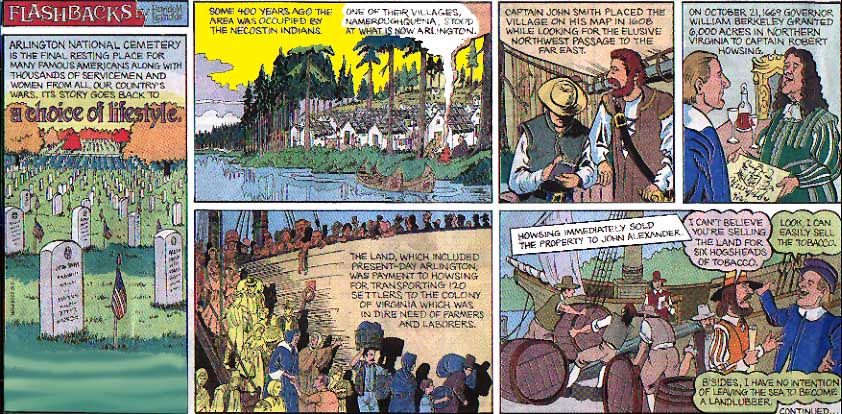
Part 2
1. Around 1670 John Alexander purcahsed land in northern Virginia
which remained a wilderness for the next century. A descendant,
Gerrard Alexander, inherited it.
2. George Washington married the widow Martha Custis in 1759
and moverd her and her children, John Parke and Martha, to his
Mount Vernon plantation, not far from Alexander's property.
3. In 1774, at the age of 20, John Parke Custis married Eleanor
Calvert. Of their 7 children, 4 survived including the youngest,
George.
4. John wanted his own plantation so, in 1778, he paid Mr. Alexander
£11,000 for 1,100 acres along the Potomac, today comprising
Fort Myer and Arlington National Cemetery.
5. John was an aide to Washington late in the Revolutionary War.
At Yorktown in 1781 he caught a fever and died that November.
6. John and Martha Washington raised John's children. President
Washington diedin 1799. After Martha died in 1802, her grandson
George inherited...
7. his father's 1,100 acres which had been held in trust for
him. Two years later Geoerge hired George Hadfield who had been
in charge of building the U.S. Capitol.
John Custis: "I want you to design my house to overlook
the Potomac and the capital city." |
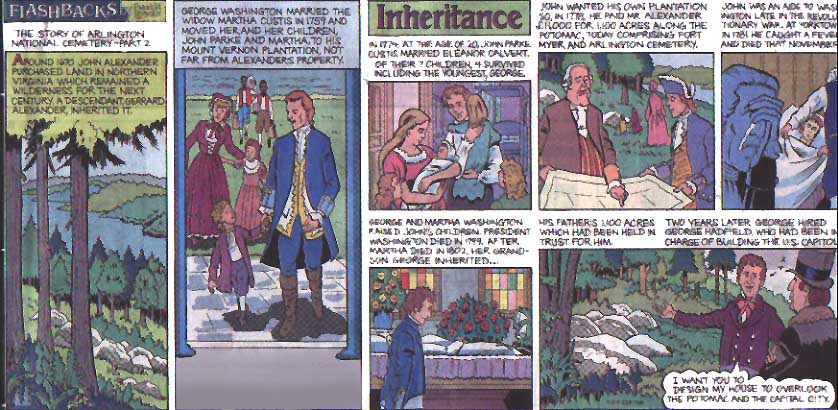
Part 3:
1. Under the guidance of architect George Hadley, construction
of George Custis' Greek Revival style mansion began in 1802.
Most of the work was done by Custis' slaves.
2. Mr. Custis Named the place Arlington House after the
original Custis estate on Virginia's eastern shore, granted to
the family by the Earl of Arlington in 1670.
3. George Custis lived in the north wing, completed in 18-2,
with his collection of memorabilia of his step-father George
Washington which he inherited from the Mount Vernon estate.
4. Custis married Mary Lee Fitzhugh ni 1804. Only one of their
four children, Mary Anna Randolph Custis, born in 1808, survived
childhood.
5. Arlington House was completed in 1818.
6. When Mary Anna was 23 she fell in love with a distant cousin,
Lieutenant Robert E. Lee.
7. But her father had misgivings about Lee. Custis: "How
can he provide for you on the meager salary of a low grade Army
officer?
8. Nevertheless, love won out. Robert and Mary Anna were married
in Arlington House on June 30, 1831. |
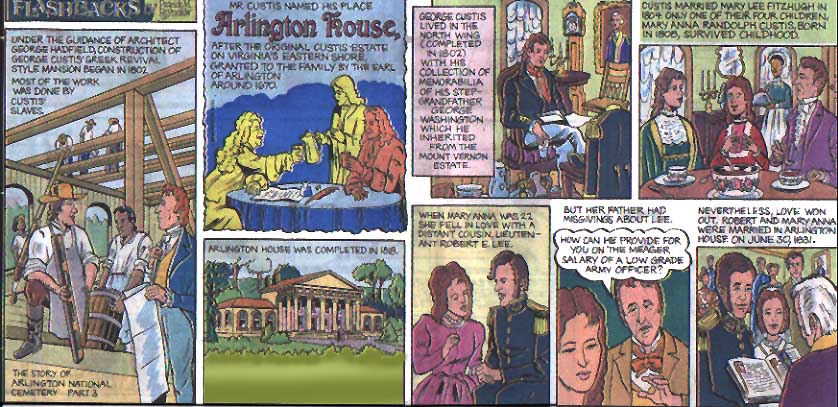
Part 4
Besides his daughter's wedding, George Custis, step-grandson
of George Washington, held many parties and social events in
Arlington House during the first half of the 19th Century.
2. Custis' daughter Mary Ann married an Army officer in 1831.
Mr. & Mrs. Robert E. Lee moved to Fort Monroe, Virginia.
However, Robert's military career required long periods away
from home.
Lee: "I don't want you living alone. Your parents will love
to have you back in Arlington."
3. So, Mary Anna returned home to Arlington House.
4. Captain Lee visited Arlington House as often as possible.
He and Mary had seven children, six of whom were born in the
mansion.
5. Throughout her adult life Mary Anna Custis Lee suffered from
rheumatoid arthritis.By 1850 she had great difficulty using the
stairs.
6. Tragedy struck in May 1853 when Mary Anna's mother died.
7. Four years later George Custis died, leaving his Arlington
House estate to his daughter Mary Anna Custis Lee.
The graves of Mr. & Mrs. Custis are near Arlington House,
now part of Arlington National Cemetery.
8. In 1857 Colonel Robert E. Lee took an extended leave from
the army to manage the affairs of Arlington House and care for
his ailing wife. |
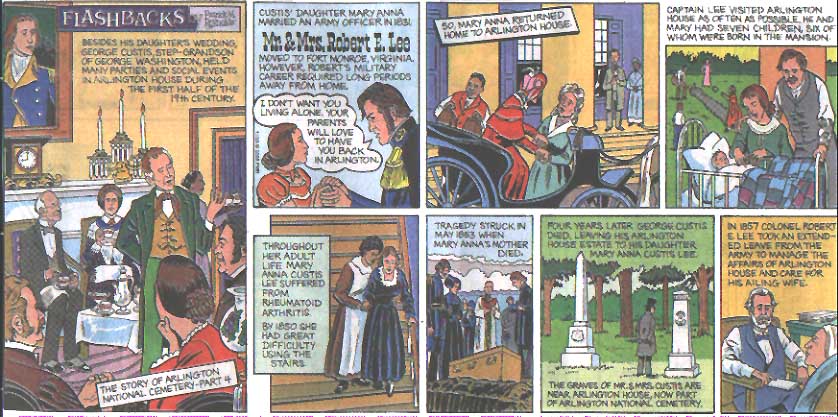
Part 5.
George Custis' Last Will and Testament granted his 1,100-acre
estate (now Arlington National Cemetery) tohis daughter Mary
Anna Lee. The place was run down and more than $10,000 in debt.
Crippled with arthritis, Mary relied on her husband Robert E.
Lee to straighten out the mess.
2. Custis also bequeathed two plantations to his grandsons and
$10,000 to each of his 4 granddaughters, all children of Col.
and Mrs. Lee.
3. Lee paid a few debts with his own money, but he knew that
he had todevote all his time to resolve the situation.
4. Taking leave from the army, Lee proceeded to make Arlington
plantation productive and profitable.
Custis' will also stipulated that his slaves would go free after
all debts were settled or in five years, whatever came first.
5. The 60+ slaves at Arlington got wind of this. Some escaped
but were soon captured. Lee rented these and other slaves to
farmers in southern Virginia.
6. Lee hated slavery and was uncomfortable giving them orders.
Lee: "..but I need them to get this place oujt of debt...then
I can set them free."
7. By autumn 1859 Lee had paid most of his father-in-law's debts,
but he still had to raise $40,000 for his daughters. Freedom
for Custis' slaves would have to wait.
8. Then, on the morining of October 17, 1859, Lt. J.E.B. Stuart
arrived with a message for Col. Lee.
"Report to the Secretary of War immediately." |
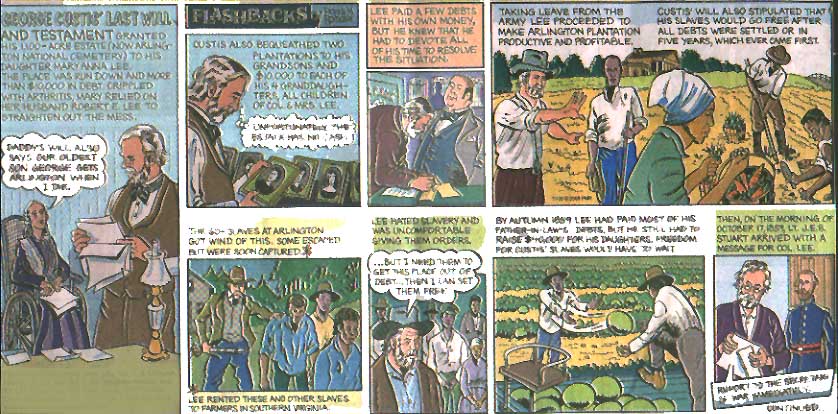
Part 6
1. October 17, 1859 -- With no time to put on his uniform, Col.
Robert E. Lee rushed to Washington with Lt. J.E.B. Stuart and
met with Secretary of War John B. Floyd. "Some sort of
insurrection just broke out in Harpers Ferry, Virginia.
2. "Take one company of Marines and four companies of Maryland
militia and restore order there."
3. Upon arriving at Harpers Ferry, Lee learned what happened.
"Last night about 18 abolitionists - both what and black
- tried to break into the armory and arsenal."
4. "Our brave townsfolk fought them. Then the abolitionists
tooksome hostages and fled into the arsenal's firehouse. I think
their leader's name is Smith."
5. Lee formulated a plan. "The Marines will encircle the
firehouse while the militia surrounds the arsenal grounds.
6. "Tomorrow morning, under a flag of truce, Stuart will
deliver a letter to the radicals inside the firehouse demanding
they surrender and release the hostages unharmed."
7. October 18, 7 A.M. "Open up! I have a letter..."
8. When the door opened a crack, Stuart recognized Smith.
9. Stuart was stationed in Kansas three years
earlier when Smith and his sons killed five men in Pottawatomie,
a pro-slavery town. "Smith's real name is John
Brown!" |
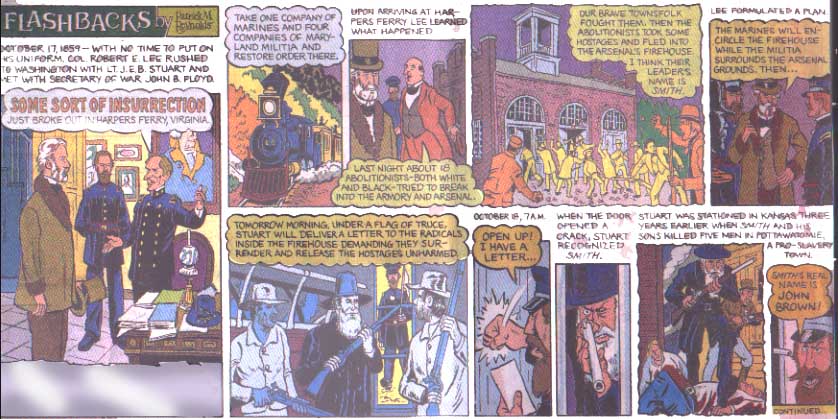
Part 7
1. The Attack on "John Brown's Fort," as the
Harpers Ferry arsenal firehouse became known, began around 7
A.M. on October 18, 1859. Lt. J.E.B. Stuart had delivered a letter
from his commanding officer Col. Robert E. Lee demanding that
Brown surrender and release the hostages. When Brown refused,
Stuart waved his hat, at which point U.S. Marines led by Lt.
Israel Green punched a hole in the door.
2. Inside, Brown and his men fired as Green and his Marines climbed
through the hole in the door.
3. Lt. Green, armed only whth a sword, lunged at Brown but the
blade glanced off Brown's belt buckle.
4. Green grappled with Brown. Finally the Marine whacked Brown
with the hilt of his sword, knocking Brown out cold.
5. It was over in three minutes. Two of Brown's men were killed.
Two Marines were wounded, on mortally. All of the hostages were
released. Later, Brown was executed
6. Afterwards, Col. Robert E. Lee had enough of running the Arlington
plantation, so he donned his unnform and, in 1860, reported for
duty in Texas. In a letter to his daughter Annie, he stated,
"It is better for all that I am here...my tastes and pursuits
did not coincide with the rest of my household." |
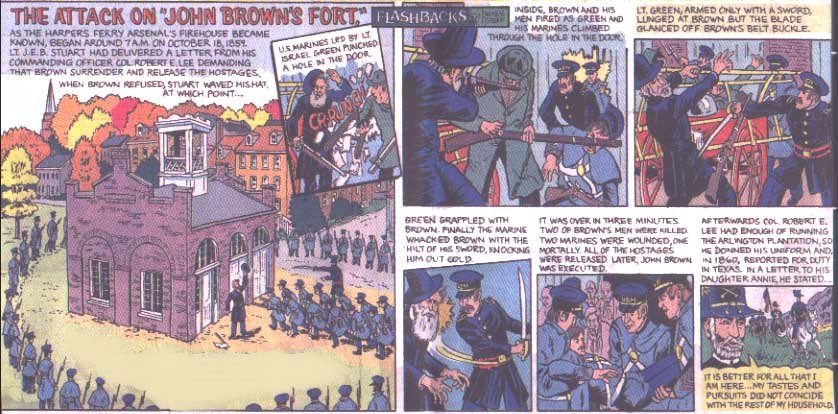
Part 8 Command Appearance
1. Col. Robert E. Lee was commanding the 2nd U.S. Cavalry Regiment
in Texas when in February 1861 he was ordered to report to the
Army's Commanding General Winfield Scott in Washington, DC no
later than April 1st.
Abraham Lincoln was also enroute to Washington for his inauguration
as President on March 4th.
2. Southerners view Lincoln and his Republican part as northern
abolitionists and a THREAT to their political power, economic
survival, and their lifestyle. Six slave states had already seceded
and formed the Confederate States of America.*
Passenger: "Well, Colonel Lee, if thar's a war, whose side
are ya gonna be on?"
Lee: " I will not fight against the South."
*Within two months there will be a total of eleven Confederate
states.
3. Lee: "But if Virginia secedes, I will join myh native
state with the SWORD."
4. Lee arrived in Arlington on March 1st and reported to Scott
a few days later.
5. They talked for about three hours. No one knows exactly what
was discussed except...
Scott: "You will have the permanent rank of full
colonel and command of the 1st Cavalry."
Lee's thoughts: Hm-m-m. He did not have to summon me here for
that."
6. Then, on April 12, troops under General Pierre Beauregard
opend fire on Fort Sumter, setting off the Civil War.
7. On April 17 Lee received invitations for two meetings on the
next day. One was with General Scott; the other was...
Lee: "with Francis Blair, Sr., a close friend and advisor
to President Lincoln."
8. Also on the 17th, the Virginia State Convention voted to secede
and join the Confederacy. Lee was not aware of this when he rode
into Washington the next day. |
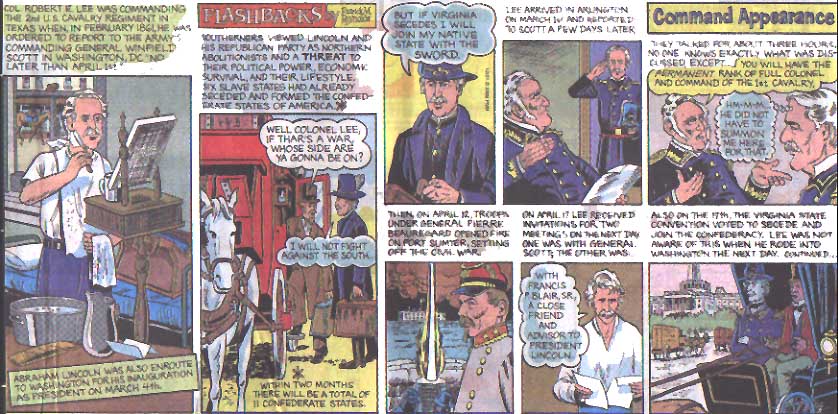
Part 9. The Offer
1. On April 18, 1861 Col. Robert E. Lee called on Francis P.
Blair, Sr., a powerful Republican and friend of President Abraham
Lincoln. Blair arranged this meeting in the home of his son,
Montgomery Blair at 1651 Pennsylvania Avenue, near the White
House.
Blair: "On behalf of the President and Secretary of War
Simon Cameron, I am offering you command of the United States
Army at the rank of Major General."
Lee replied, "I oppose secession and I hate war...but I
will take no part in an invasion of the southern states."
2. Then Lee walked to General Scott's office and told him the
same thing.
Scott: "Lee, I'm afraid you're making a great mistake, but
I feared it would be so."
Lee: "Good-bye, Sir."
3. The next day, after finding out about the vote for Virginia's
secession, Lee wrote a letter of resignation to General Scott.
4. On the 22nd of April, Lee left for Richmond.
Lee: "I will offer my servises to the state of Virginia."
5. Little did Lee realize that he would never again set foot
in the place he considered home–Arlington House.
6. In Richmond Governor "Honest John" Letcher declared,
"Robert Edward Lee is hereby commissioned a major general
in command of ALL military forces in the Commonwealth of Virginia."
7. Later, the U.S. Department of War confiscated the Lee plantation
and converted it into Arlington National Cemetery. |
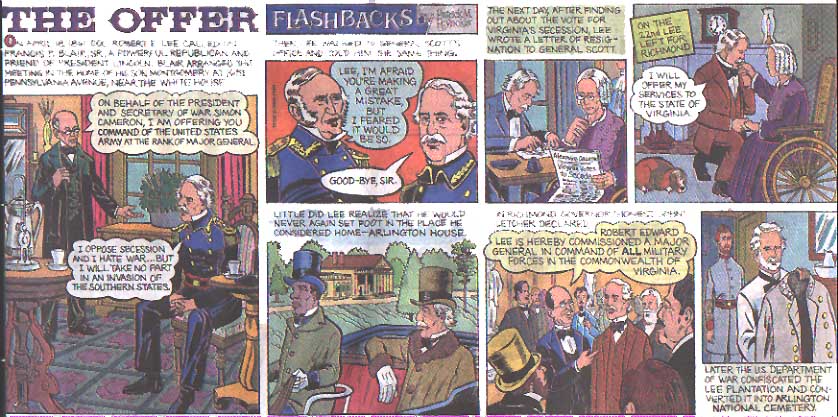
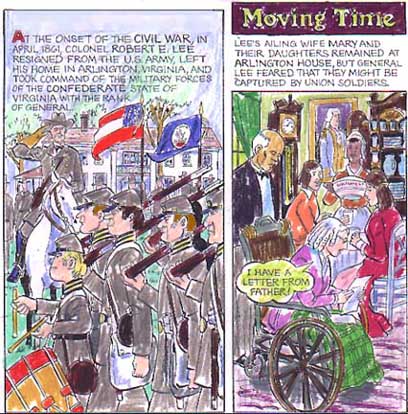 |
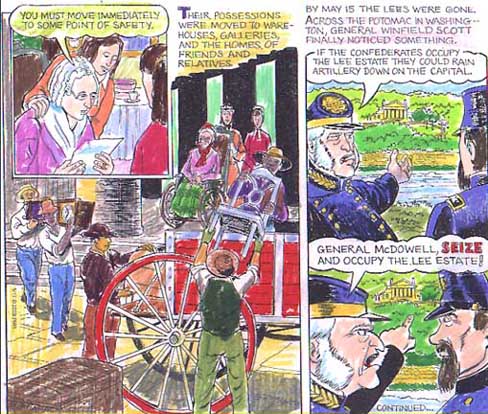 |
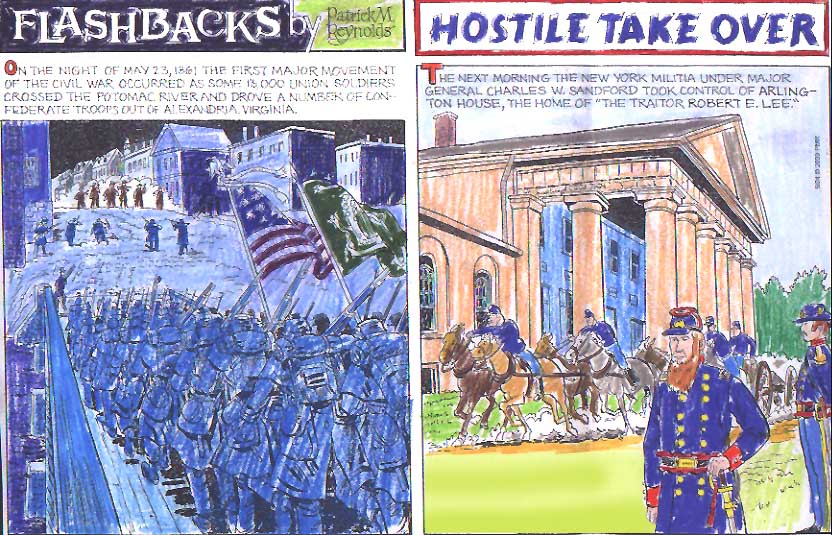 |
|
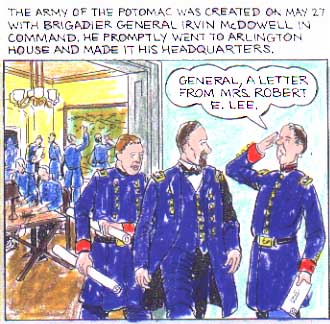 |
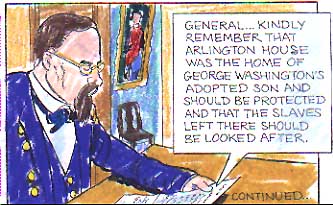 |
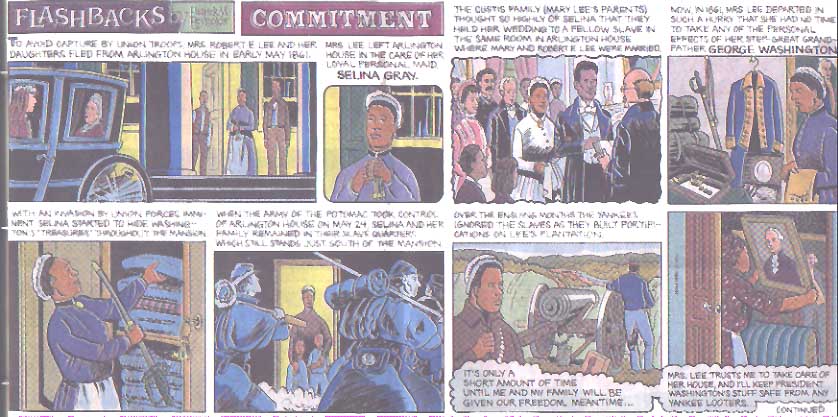
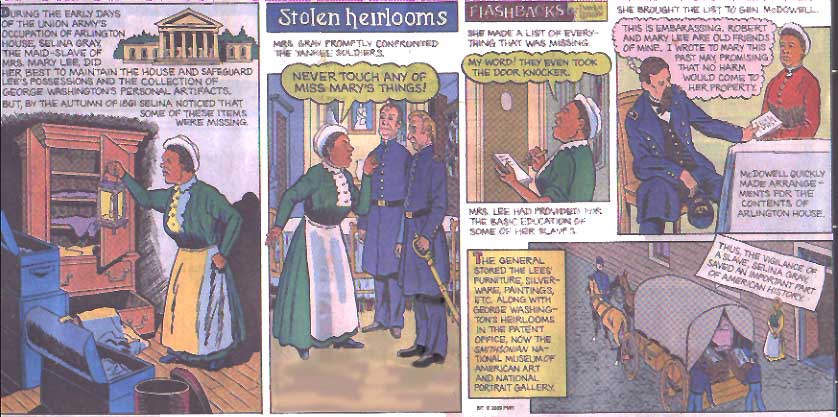
The Tricky Tax
1. On June 7, 1862 Congress passes "an act for the collection
of direct taxes in the insurrectionary districts within the United
States."
2. Two U.S.representatives explain the new tax...
First rep, "It's actually a scheme for the federal government
to grab private property in the South for our own use."
Second rep, "And to capture some rebels. Here's how it works:
3. "After our troops capture a Confederate area, our agents
will assess the value of each property which will
4. "determine how much taxes the owner owes. Now
here's the rub. The owners must pay his taxes in person!
5. "Most of the propert owners in the south are either Confederate
soldiers or sympathizers, so when they show up at the tax office,
we'll simply arrest them.
6. "If they fail to come in and pay up, the government will
confiscate their property and sell it at auction."
7. The Arlington estate, home of General and Mrs. Robert E. Lee,
is occupied by Union forces. It is assessed at $26,810. Mrs.
Lee, the owner, must personally pay a tax of $92.07.
8. Mary Lee, now an invalid, is living with a daughter in Richmond.
"Mother, please do not go to Alexandria to pay this tax.
The Yankees will arrest you and hold you hostage." |

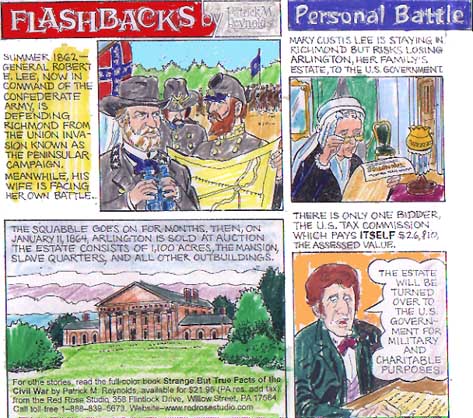 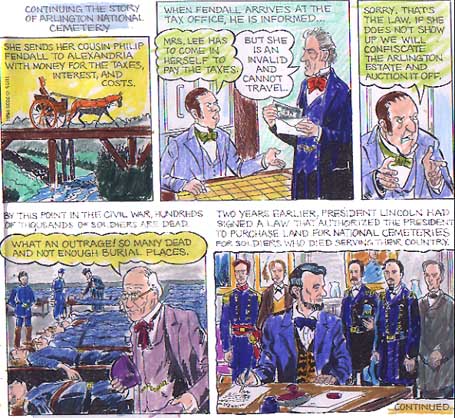
1. William Henry
Christman, a laborer from Easton, Pennsylvania , enlists
in Company G, 67th Regiment of Pennsylvania Volunteers on March
25, 1864 and received "a $60 cash bounty and a $300 promissory
note from the federal government."
2. Weeks later, on May 1, Private Christman comes down with measles
and is admitted into Lincoln Hospital, a mile east of the Capitol
in Washington.
3. His condition worsens. On May 11 he dies of peritonitis, a
toxic inflammation of the membrane lining the abdominal cavity.
4. Word of Pve. Christman's death reaches Brig. General Montgomery
Meigs, Quartermaster General of the U.S. Army, whos many duties
include the procurement and management of military cemeteries.
Meigs to aide, "Bury him in the Arlington estate."
5. Meigs: "Arlington is the home of General Robert
E. Lee and I plan to turn that traitor's place into a cemetery."
6. On May 13, 1864 Private Christman is buried near the northeastern
boundary of the Lee estate close to a small cemetery reserved
for the plantation slaves.
7. Private William Henry Christman is the first serviceman
buried in what will soon become Arlington National Cemetery.
Christman's grave is located at Sector 27, Lot 19, shown here
on a section of a full color, laminated, illustrated Map of
Arlington National Cemetery by Jamshid Kooros. The full map
is shown below, along with information for ordering it. |
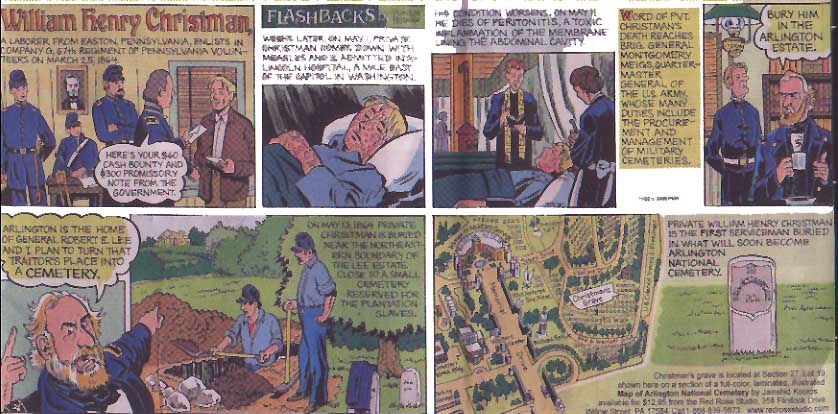
The General's Idea
1. Brigadier General Montgomery
Cunningham Meigs was Quartermaster General of the U.S. Army during
the Civil War, meaning he procured supplies except ordnance,
controlled construction of depots, etc., and provided transportation.
2. Every day soldiers were dying in battle or in hospitals. Among
Meigs's responsibilities was setting up military cemeteries.
3. On June 16, 1864 Meigs sent a proposal to Secretary of War
Edwin Stanton that a military cemetery be placed on the grounds
at Arlington House, the former home of Confederate General and
Mrs. Robert E. Lee.
4. A few hours later Stanton issued an order, "Part of the
Arlington Estate, not exceeding 200 acres...
5. "be surveyed for this purpose. Gen. Meigs will carry
out this order."
6. Although Meigs hailed from Georgie, he hated southerners,
especially Gen. Lee whom he regarded as traitors. "The graves
must come right up to the mansion so nobody could ever live there
again."
7. However, the officers stationed inthe mansion ignored the
general's directive.
1st Soldier: "We don't like the idea of living next
to graves."
2nd Soldier: "Bury the dead as far from the mansion
as possible." |

Without Ceremonies
1. Secretary of War Edwin Stanton
formally established Arlington National Cemetery on June 15,
1864 on the former estate of General and Mrs. Robert E. Lee.
2. Meanwhile the Union was losing thousands of men at the battles
of Cold Harbor and Petersburg.
3. By the end of June 1864 some 2,600 soldiers had been interred
at Arlington
At first virtually every man buried here came from families that
were too poor to have their sons, fathers, and husbands shipped
home.
4. Gen. Montgomery Meigs, supervisor of the cemetery, visited
Arlington in August and discovered that his directive to bury
the bodies right next to the Lee mansion had not been followed.
He exploded, "I want every dead soldier in every hospital
in Washington brought here immediately."
5. Twenty-six corpses were delivered to Arlington and Meigs personally
oversaw their burials in Mrs. Lee's rose garden. They rest there
today, surrounding the restored garden.
6. The high number of burials in a short span of time created
a problem for Meigs. "I am having a hard time getting enough
chaplains to conduct burial services.
7. "Consequently many funerals are conducted without ceremonies."
The first grave markers were made of wood with names often misspelled
and little or no personal information. |

Health Hazard
1. Several battles in the Civil
War--Bull Run, Monacacy, Fredericksburg--were fought near Washington,
DC. Thousand on both sides were killed. Many of these soldiers
were left where they had fallen or were buried in hallow, unmarked
graves. This posed a health problems for nearby communities.
2. When the war ended in 1865 General Montgomery Meigs continued
to run the U.S. Army's Quartermaster Department and was still
responsible for military cemeteries. In 1866 he declared, "The
remains of every unidentifiesd soldier found within a 25-mile
radius of Washington will be brought to Arlington for burial."
3. By then these bodies were badly decomposed. In most cases
only fragments were recovered, and it was impossible to determine
if the bones belonged to a Union or Confederate soldier.
4. These remains would be buried in a concrete-lined vault in
the rose garden of Mrs. Robert E. Lee on orders from General
Meigs. |
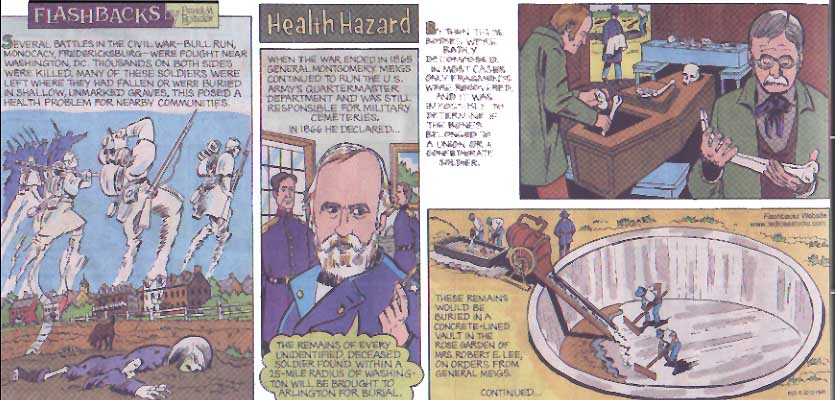
The Civil
War Unknowns
1. For several months in 1866 the
U.S. Army recovered the remains of unidentified soldiers from
battlefields around Washington, DC and brought them to Arlington
National Cemetery for burial in a huge cement-lined vault.*
*By then this underground vault in Mrs. Robert E. Lee's rose
garden had been divided into compartments.
2. A reporter for the National Intelligencer described
the scene, "...a terrible spectacle...down into this gloomy
recepticle are cast the bones of such soldiers as perished on
the field and either were not buried at all or were so covered
up as to have their bones intermingle together.
3. "There wer piled together skulls in one division, legs
in another, arms in another, and ribs in another, what were estimated
as the bones of two thousand human beings."
4. Dedicated inSeptember 1866 this nomument stands atop the vault
that contains the remains of 2,111 soldiers, presumably of both
Union as well as Confederate groops. This memorial was the first
at Arlington to honor soldiers who wer killed in action. |
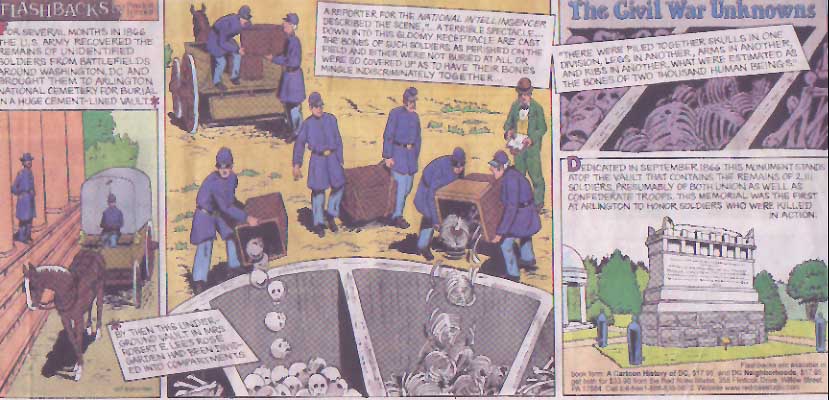
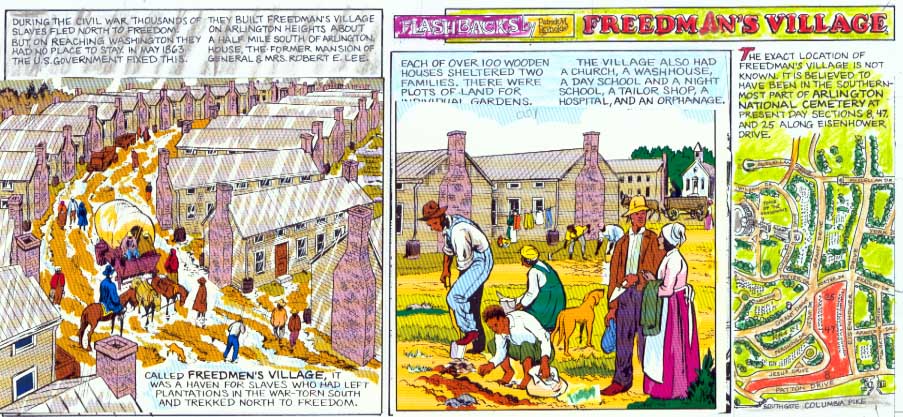
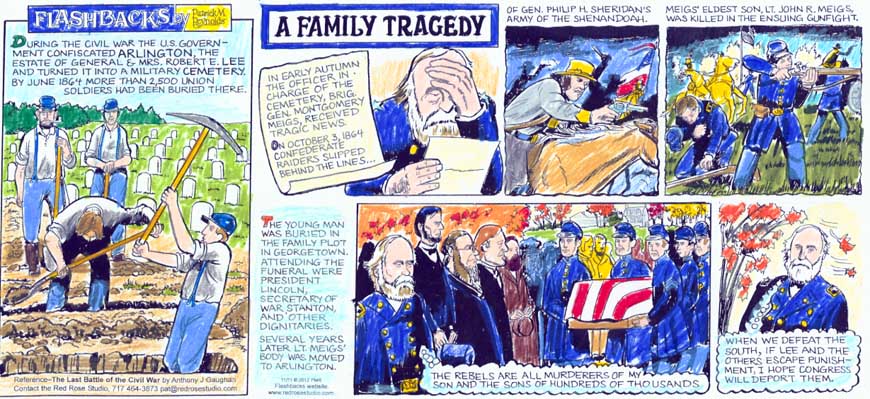
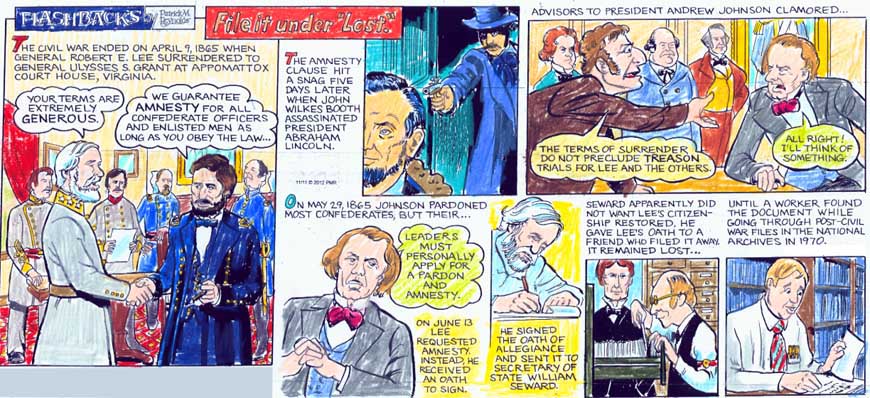
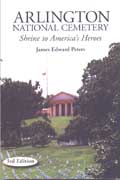 |
Arlington
National Cemetery Shrine to America's Heroes
by James Edward Peters
First published in 1986, now in its third edition, this comprehensive
guidebook vividly chronicles the story of Arlington from its
checkered origin to its present glory. Here are brief biographies
of many of its 300,000 decedents: presidents and privates; officers
and astronauts; actors, writers, and Supreme Court justices.
Described also are the stories behind more than 40 monuments
and memorials on the grounds, including the Tomb of the Unknowns
and the 9/11 Memorial. Contains a small fold-out map on the inside
back cover. Pages 312 + gives information on how to reserve a
burial spot and other regulations on family plots, special tombstones,
etc.
6" x 9" 360 pages, index, photos, paperbound
#114 Arlington National Cemetery $19.95  |
 |
The Last Battle
of the Civil War United States Versus Lee, 1861-1883
by Anthony J. Gaughan
The cartoon sequence you just read is a prelude to the two-decade
battle waged by General Lee's family against the U.S. government
for its illegal seizure of their mother's estate. With all the
trappings, suspense, twists, and turns of a modern-day courtroom
drama, here is the true story of the legal shenanigans and wheeling
& dealings of this 19th century lawsuit. Perhaps most important,
this book examines the timeless questions relating to citizens'
rights and the role of law in the midst of war and a contentioius
peace.
6" x 9" 248 pages, index, photos, hardbound ISBN
978-0-8071-3774-1
#526 Last Battle of the Civil War $48.00 
|
 |
Robert
E. Lee - A Biography
by Emory M. Thomas
In doing Flashbacks, we use a lot of reference books.
In our opinion, this one is the best. Aside from its accuracy
and non-biased approach, It is an easy, fast-moving, and enjoyable
read. From his struggles as a youth with his father's humiliation
(find out in the book), to his frustrating marriage into a proper
and prominent family, Lee, the uncertain scion, skilled engineer,
consumate warrior, and college president--was actually an enigmatic
person of latent passions--all revealed in this book. As showin
in this cartoon, his father in law's always looked down on Lee.
In his will, old man Custis left Lee's wife and kids everything.
Lee inherited a building lot in Washington and the task of paying
ol' Custis' debts.
6" x 9" 473 pages, index, photos and battle maps, paperbound
#494 Robert E. Lee - Bio $19.95  |
| Below is a partial
scan of a much larger laminated, beautifully map of Arlington
National Cemetery. On the reverse of this map is a brief history
of the cemetery and, most important to a visitor, numbers that
correspond to locations on the map of the gravesites of prominent
people buried here. Ordering data appears beneath the map. |

11" x 17" folded laminated map
#495 Arlington Cemetery Map $9.95  |






























